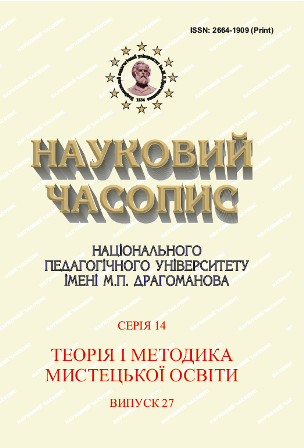Psychological concept of communicative interaction in the orchestra team
DOI:
https://doi.org/10.31392/NPU-nc.series14.2019.27.07Keywords:
orchestral group, conductor, artistic, communicative interaction, creative processAbstract
Observations on the creative activity of the orchestra group and practice prove, that unity of actions of orchestrators cannot be achieved by mechanical fulfilment of requirements of the conductor. It is possible under conditions of establishing effective relationships in the orchestra, aimed at harmonizing the play technology, the subordination of individual feelings and emotions. It is recognized that the organization of creative activity (and the functioning of the orchestra as a whole) is directly dependent on the interaction between the conductor and its participants. Therefore, without reaching conductor professional qualification, it is impossible to solve creative tasks with the team. The basis of the conductor’s communication process is the establishment of mutual mental contacts and communications with the performers, the exchange of the information between the partners of the creative act, as well as interaction and psychological influence. All of these components are inextricably interconnected and cannot exist separately. Establishing a psychic contact with an orchestra cannot be a “mechanical” transfer of attention from one object to another. The communicative process requires considerable intellectual tension and wilful effort, as a large number of people are involved in the creative process. Psychological contacts are heterogeneous in structure, nature, and content. Conditionally they can be divided into «external» and «internal». External ones are built on «controlling attention» and aimed at solving «organizational tasks», creating channels of mutual circulation of information, exercising control and regulation of the orchestra’s actions. At the same time, internal contacts (actually psychological ones) cover the subtle intellectual realm that is associated with the creative process. Internal contact is a way of grasping the musician’s spiritual world, penetrating his «creative self». Such communication, overcoming on its way the outer shell of the «visible», encompasses all the subtle nuances of the artist’s deep creativity. Thus, communicative interaction is born in the process of perception by the performers of the real sound of the whole team, the actions of partners, the instructions of the conductor. Comparison of this information with the real sound is the basis for its correction both by the conductor and the artists: their timely reaction to the requirements of the conductor, the results of the analysis of the partners’ actions performed by the correction of personal performance, emotional response to the artistic influence of music is a basic prerequisite for effectiveness musical interaction. Basing on the unified understanding of the music composition essence, interpreting tasks and the content of performing operations, the orchestra participants form identical aesthetic evaluations of the work, adequate emotional attitude to the music. Consequently, communicative interaction aims at reconciling both - performance technology, feelings and emotions.
References
Brovko M. M. Mystetstvo yak estetychnyi fenomen [Art as an aesthetic phenomenon]. Kyiv : Vipol, 1999. 239 s. (in Ukrainian)
Zhyvov V.L. Teoryia khorovoho yspolnytelstva [The theory of choral performance]. M.,1998. S. 130 (in Russian)
Yerzhemskiy G.L. Psikhologiya dirizhirovaniya: Nekotorye voprosy ispolnitelstva i tvorcheskogo vzaimodeystviya dirizhera s muzykalnym kollektivom [Conducting Psychology: Some Issues in the Performance and Creative Conduct of a Conductor with a Music Company]. M. : Muzyka, 1988. 80 s. (in Russian)
Karnegi D. Kak zavoevat druzey i okazyvat vliyanie na lyudey. [How to make friends and influence people]. Vladivostok : iz-vo Dalnevostochnogo un-ta, 1991. 203 s. (in Russian)
Kondrashyn K. P. Mir dirizhera. [World of conductor]. Leningrad: Muzyka, 1975. 191 s. (in Russian)
Lokarieva, H. V. Teoretychni ta metodychni zasady zastosuvannia khudozhno-estetychnoi informatsii u pidhotovtsi sotsialnoho pedahoha do profesiinoho spilkuvannia [Theoretical and methodological foundations of the use of artistic and aesthetic information in preparing a social teacher for professional communication] : Dys. ... d-ra ped. nauk: 13.00.04 / Zaporizkyi derzh. un-t. Zaporizhzhia, 2004. 599 s. (in Ukrainian)
Makarenko H.H. Tvorchist dyryhenta v konteksti intehratyvnoho pidkhodu [Conductor creativity in the context of an integrative approach] : Dys... d-ra nauk: 17.00.01 / Natsionalna muzychna akademiia Ukrainy im. P.I.Chaikovskoho. Kyiv, 2006. 378 s. (in Ukrainian)
Stanislavskiy K. Rabota aktera nad soboy [The actor’s work on himself]. Moscow : Iskusstvo, 1985. 480 s. (in Russian)
Stolovych L. N. Zhyzn – tvorchestvo – chelovek [Life - creativity - human]. Moscow : Polyzdat, 1985. 415 s. (in Russian)

